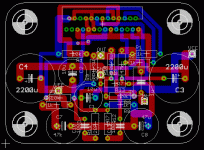BWRX said:Has anyone done a Gainclone PCB using surface mount parts? It seems you'd be able to tidy up the layout quite a bit as well as make it more compact. Not that it really needs to be, but why not if it's possible.
Yes, my only amplifier based on NS Overture chip. Please have a look:
http://www.errapart.com/gallery/Andrei_25AC311?page=4
An externally hosted image should be here but it was not working when we last tested it.
An externally hosted image should be here but it was not working when we last tested it.
Schematic & PCB layout:
http://194.204.26.104/~andrei/diyaudio.com/MONOFULL3886_SCHEMATIC.pdf
http://194.204.26.104/~andrei/diyaudio.com/MONOFULL3886_PCB.pdf
If the power filter capacitors are the same or smaller than on my pictures, the screwdriver will fit nicely between them to fix the LM3886 to the heatsink.
LM4780
jackinnj is absolutly correct, you should first read the data sheets learn the how and why, before jumping in feet first.
The 100nf caps are important and should be placed close to the chips power legs, they are there to help prevent high frequency oscillations. Mil standards for clearance between traces and trace widths are for reasons, i.e., power carrying capacity and safety.
The use of a ground plane is really not a good idea unless you are very adept at design layouts. These chip are wide bandwidth amplifiers and will oscillate. A ground plane in this case is usally a good idea, but unless great care is taken to match impeadance levels around the plane you will create loops of greater and lesser impeadance causing loops, hum, oscillations ect.....
jackinnj is absolutly correct, you should first read the data sheets learn the how and why, before jumping in feet first.
The 100nf caps are important and should be placed close to the chips power legs, they are there to help prevent high frequency oscillations. Mil standards for clearance between traces and trace widths are for reasons, i.e., power carrying capacity and safety.
The use of a ground plane is really not a good idea unless you are very adept at design layouts. These chip are wide bandwidth amplifiers and will oscillate. A ground plane in this case is usally a good idea, but unless great care is taken to match impeadance levels around the plane you will create loops of greater and lesser impeadance causing loops, hum, oscillations ect.....
DJ Exprice said:Diagram:
that type of heatsink mounting isn't usually desired for DIY use. for one, the heatsink now must be elevated and cannot be part of the chassis. its usually nicer to be able to attach the heatsink flush with the PCB as this allows the chip to be in the center of the heatsink regardless of the heat sink's height. it also allows more mounting options.
not that your way doesn't work, its just less reusable.
theChris said:
that type of heatsink mounting isn't usually desired for DIY use. for one, the heatsink now must be elevated and cannot be part of the chassis. its usually nicer to be able to attach the heatsink flush with the PCB as this allows the chip to be in the center of the heatsink regardless of the heat sink's height. it also allows more mounting options.
not that your way doesn't work, its just less reusable.
This room is also a good idea if you need space for thermal grease and a sil-pad, or another piece of metal could be used as a spacer...

My design is a little funky now. I'll make a new one in the near future.
DJ Exprice:
You may wish to check this one out:
http://www.moxtone.com/LM4780.htm
It works without a hitch.
Regards,
Milan
You may wish to check this one out:
http://www.moxtone.com/LM4780.htm
It works without a hitch.
Regards,
Milan
- Status
- This old topic is closed. If you want to reopen this topic, contact a moderator using the "Report Post" button.
